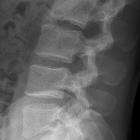scheuermann disease










Scheuermann disease, also known as juvenile kyphosis, juvenile discogenic disease , or vertebral epiphysitis, is a common condition which results in kyphosis of the thoracic or thoracolumbar spine. The diagnosis is usually made on plain film.
Epidemiology
- occurs in ~5% (range 0.4-8%) of the general population
- typical age of presentation is between 12 and 17 years
- slight male predominance
Pathology
Its exact etiology is unknown but a proposed mechanism is by aseptic necrosis of the vertebral apophysial rings. Excessive axial spine load due to heavy weightlifting may also contribute.
There is a strong hereditary predisposition (perhaps autosomal dominant) with a high degree of penetrance and variable expressivity.
Location
Occurs in the thoracic spine in up to 75% of cases, followed by the thoracolumbar spine combined and occasionally lumbar and rarely cervical spine.
Classification
- type I: thoracic spine only
- type II
- affecting the lower thoracic spine and lumbar spine
- some authors have proposed the term lumbar Scheuermann disease for a variant affecting the lumbar region
Radiographic features
To apply the label of classical Scheuermann disease, the Sorensen criteria need to be met :
- thoracic spine kyphosis >40° (normal 25-40°) or
- thoracolumbar spine kyphosis >30° (normal ~zero degrees)
and
- at least 3 adjacent vertebrae demonstrating wedging of >5°
Other signs include:
- vertebral endplate irregularity due to extensive disk invagination
- intervertebral disk space narrowing, more pronounced anteriorly
The condition is associated with
Treatment and prognosis
Management is largely dependent on the degree of kyphosis:
- <50°: conservative, stretching, postural changes
- 50-75°: brace
- >75°: surgery
History and etymology
It is named after the Danish orthopedic surgeon and radiologist Holger Werfel Scheuermann (1877-1960) who first described it in 1920 as osteochondritis deformans juvenilis dorsi .
Siehe auch:
und weiter:

 Assoziationen und Differentialdiagnosen zu Morbus Scheuermann:
Assoziationen und Differentialdiagnosen zu Morbus Scheuermann:


